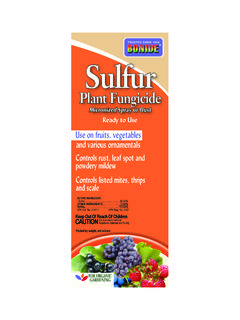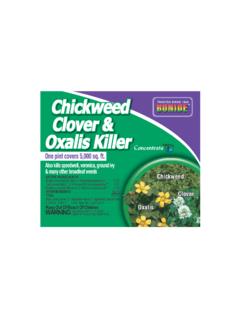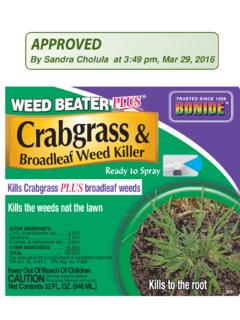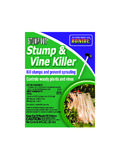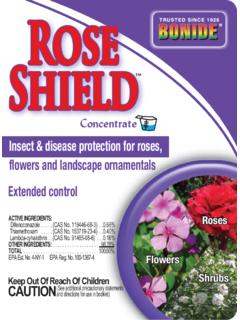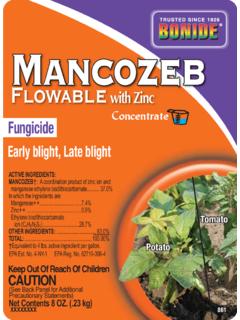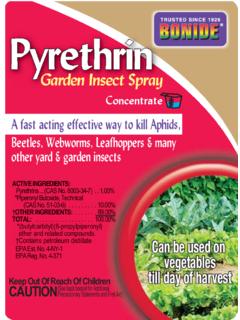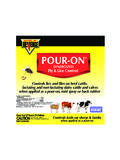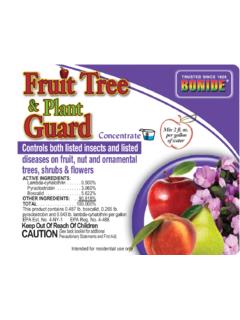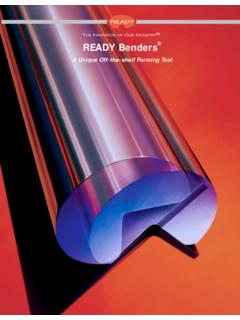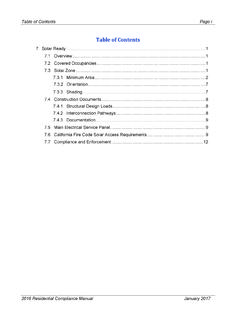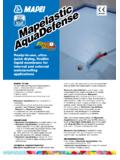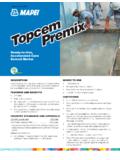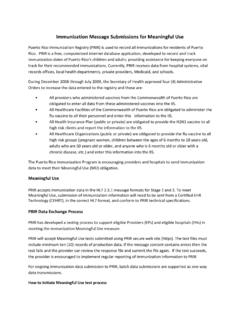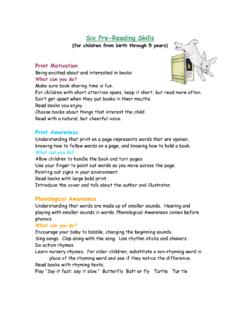Transcription of Ready to Use Controls listed plant diseases using …
1 Controls listed plant diseases using low concentrations of copper775775(See back booklet for additional Precautionary Statements and First Aid)Net Contents 32 FL. OZ. (946 ML.)Keep Out Of Reach Of ChildrenCAUTIONFor flowers, fruits & vegetablesACTIVE INGREDIENT: Copper Octanoate .. (Copper Soap) .. INGREDIENTS:.. :.. copper equivalent .. Est. No. 4-NY-1 EPA Reg. No. 67702-1-4 DownyMildewDownyMildewBlackSpotBlackSpot PowderyMildewPowderyMildewEarly BlightEarly BlightReady to UseLiquidJOB 123117123117 Liquid Copper Qt RTU 1 12/15/16 1:10 PMManufactured under a license of W. Neudorff GmbH KG, Reg. No. 67702-1-4 EPA Est. No. 4-NY-1 Distributed by:Bonide Products, Sutliff RoadOriskany, NY 13424 QuartBNReady to use 3 Dormant and growing season liquid copper fungicide 3 For organic gardening 3 For a wide range of listed plant diseases : powdery mildew, rusts, blackspot, leaf & fruit spot, downy mildew, fruit rot, late blight LIQUIDJob 118438PG 1118438 Copper Fungicide 775B12 16/24/16 1:46 PMPG 2It is a violation of Federal Law to use this product in a manner inconsistent with its labeling.
2 Read and follow all applicable directions and precautions on this label before FOR USEU sing the provided hand-pump sprayer, spray all plant surfaces (top and bottom of leaves) thoroughly with this product. One quart will treat 10 square yards ( L will treat 10 m2).Begin treatment 2 weeks before disease normally appears or when disease first appears, and repeat at 7 to 10 day intervals for as long as needed. Re-apply after control powdery mildews, begin treatment 2 weeks before disease normally appears. Alternatively, begin treatment when disease first appears, and repeat at 7 to 10 day intervals for as long as needed. Spray every 7 days when the amount of disease is increasing rapidly. If possible, time applications so that 12 hours of dry weather follow application. On plants that are very susceptible to powdery mildew, such as home-greenhouse-grown cucumber, it is best to spray the plants twice a week during the first 2 weeks after emergence, and weekly thereafter.
3 On outdoor plants, re-apply after control downy mildews, leaf and fruit spots, blights, and rust, begin treatment 2 weeks before disease normally appears or when weather forecasts predict a long period of wet weather. Alternatively, begin treatment when disease first appears, and repeat at 7 to 10 day intervals for as long as needed. Spray all plant parts thoroughly. Re-apply following heavy rain. Apply every 7 days when the amount of disease is increasing rapidly. Sprays every 5 to 7 days should be used for preventing late blight on potatoes and tomatoes. If possible, time applications so that at least 12 hours of dry weather follows prevent fruit rots, spray this product thoroughly onto flowers and fruit. Apply at the start of flowering and continue every 7 to 10 days until DIRECTIONS118438 Copper Fungicide 775B12 26/24/16 1:46 PMPG 3 Fungicidal sprays are especially warranted when weather forecasts predict a long period of wet weather.
4 Re-apply after DIRECTIONS Cont. Note: Do not mix this product with lime. Certain Vinifera and French Hybrid varieties may be sensitive to copper sprays resulting in marginal leaf burn. Before spraying these varieties, consult your State Experiment Station or make test mildew, Black rot, Phomopsis Cane and Leaf Spot, Powdery mildewSpray all plant surfaces thoroughly with this product . For best control begin treatment when new growth reaches inch and repeat at 7 to 14 day intervals throughout the growing mold (Fruit rot)Spray all plant surfaces thoroughly with this product. For best control begin treatment at the end of bloom and repeat at 7 to 14 day leaf curlSpray all plant surfaces thoroughly with this product. Can be used to control peach leaf curl. Apply as a dormant spray in late fall during a period of dry PLANTSS pray all plant surfaces thoroughly with this product.
5 Begin treatment when new growth emerges and repeat every 7 to 10 days for as long as needed to control violet - Bacterial leaf spot and blight, Botrytis blight, Leaf spot, Powdery mildewAluminum plant - Bacterial leaf spot and blight, Anthracnose, Leaf spot, Rhizoctonia blightAralia - Anthracnose, Bacterial leaf spot and blight, Leaf spotAreca palm - Leaf spot118438 Copper Fungicide 775B12 36/24/16 1:46 PMPG 4 Bird's nest fern - Bacterial leaf spot and blightBoston fern - Bacterial leaf spot and blight, Botrytis blight, Rhizoctonia blightBromeliad - Anthracnose, Bacterial leaf spot and blight Cactus - Leaf spotCaladium - Bacterial leaf spot and blight, Rhizoctonia blightChinese evergreen - Anthracnose, Bacterial leaf spot and blight, Leaf spot, Rhizoctonia blight, Soft rotCorn plant - Bacterial leaf spot and blight, Botrytis blight, Leaf spotCroton - Anthracnose, Bacterial leaf spot and blightDevils ivy - Bacterial leaf spot and blight, Rhizoctonia blightDieffenbachia - Bacterial leaf spot and blight, Leaf spot, Rhizoctonia blightDracaena - Bacterial leaf spot and blight, Botrytis blight, Leaf spotDwarf Schefflera - Bacterial leaf spot and blight, Leaf spotEarthstar - AnthracnoseEnglish ivy - Anthracnose.
6 Bacterial leaf spot and blight, Botrytis blight, Leaf spot, Rhizoctonia blightEuphorbia - Rhizoctonia blightFishtail palm - Bacterial leaf spot and blight, Leaf spotGrape ivy - Anthracnose, Botrytis blight, Downy mildew, Powdery mildew, Rhizoctonia blightIndia-rubber tree - Leaf spot, Botrytis blightJapanese fatsia - Bacterial leaf spot and blight, Leaf spot, Rhizoctonia blightLadyfinger palm - Leaf spotLipstick vine - Botrytis blight, Leaf spotNephthytis - Bacterial leaf spot and blight, Leaf spot, Rhizoctonia blightNerve plant - Rhizoctonia blightNorfolk Island pine - Colletotrichum needle blightORNAMENTAL PLANTS Copper Fungicide 775B12 46/24/16 1:46 PMPG 5 Oyster plant - Leaf spotPeperomia - Leaf spot, Rhizoctonia blightPhilodendron - Anthracnose, Botrytis blight, Leaf spot Pothos - Bacterial leaf spot and blight, Rhizoctonia blightPrayer plant - Leaf spotRattlesnake plant - Bacterial leaf spot and blight, Leaf spotSchefflera - Anthracnose, Bacterial leaf spot and blight, Leaf spot, Rhizoctonia blightSedum - Leaf spotSnake plant - Bacterial leaf spot and blight, Leaf spotSpathe flower - Leaf spot, Rhizoctonia blightStaghorn fern - Bacterial leaf spot and blight, Rhizoctonia blightSwiss cheese plant - Bacterial leaf spot and blight, Anthracnose, Rhizoctonia blight, Soft rotTailflower - Anthracnose, Bacterial leaf spot and blight, Leaf spot, Rhizoctonia blight, Soft rotTi plant - Anthracnose, Leaf spotUrn plant - Anthracnose.
7 Bacterial leaf spot and blightVarious palms - Leaf spotWax plant - Botrytis blight, Leaf spot, Rhizoctonia blightWeeping fig - Leaf spotYucca - Leaf spotZebra plant - Botrytis blight, Leaf spot, Rhizoctonia blightThis product may cause some copper toxicity on some plant species. Before spraying a specific plant species, consult your State Experiment Station or make a test PLANTS Copper Fungicide 775B12 56/24/16 1:46 PMPG 6 Blackspot, Downy mildew, Gray mold, Leafspots, Powdery mildew, RustSpray all plant surfaces thoroughly with this product. Begin treatment when new spring growth emerges and repeat every 7 to 10 days for as long as needed to control disease. This product may cause some copper toxicity on some roses. Copper toxicity appears as purple product decomposes to form soluble copper, and fatty acid, both of which can be used by microbes and copper is one of the oldest fungicides and bactericides, used to control a wide range of plant diseases .
8 This product is a patented, fixed copper fungicide, made by combining a soluble copper fertilizer with a fatty acid. The copper and the fatty acid combine to form a copper salt of the fatty acid, known technically as a true soap. The copper soap fungicide Controls many common diseases using low concentrations of copper. The net result is an excellent vegetable, fruit and ornamental fungicide. This product is suited for use in domestic circumstances, both indoors and wide range of bacteria and fungi attack plants, however, they generally only cause a few types of diseases . When using this product, it is important to identify the type of disease in order to use the best method of disease product Controls diseases of a wide range of plants, listed on this label, including many vegetables, fruit and ornamentals.
9 As with most fungicides, This product acts to protect plants from infection. Therefore, it is important to have This product on the leaf, flower or fruit before the pathogen is able to cause an Copper Fungicide 775B12 66/24/16 1:46 PMPG 7 Powdery mildews tend to occur on the upper leaf surfaces, as though a white powder was sprinkled onto the plant . Powdery mildews can form a dense, white, cottony mass, making the whole leaf appear white. They are also commonly found on stems. Powdery mildews rarely kill plants. Most fungal diseases require water to infect plants. Powdery mildews are unique in that they do not require water for infection. Hence, under home greenhouse conditions, powdery mildews can become severe. Shade and dense plantings also promote powdery mildews commonly occur on the following plants: bean, beet, broccoli, brussel sprouts, cauliflower, cabbage, cantaloupe, chard, chicory, chive, cucumber, currant, endive, gooseberry, hop, kale, kohlrabi, lettuce, lilac, pea, pumpkin, rose, rutabaga, spinach, squash, strawberry, turnip, and mildews tend to occur on the lower leaf surfaces.
10 Downy mildews are much finer than powdery mildews, and appear as fine white cotton, similar to duck down. Downy mildews can rapidly kill plant leaves during wet, cool weather, but are inhibited by hot dry weather. White rust is caused by fungi related to the downy mildews and occurs as small white blisters, full of white powder, that appear on plant leaves. The white powder is rust mildews commonly occur on the following plants: bean, beet, broccoli, brussel sprouts, cauliflower, cabbage, cantaloupe, chard, chicory, chive, corn, cucumber, endive, garlic, hop, kale, kohlrabi, leek, lettuce, onion, pea, pumpkin, rutabaga, shallot, spinach, squash, sunflower, tobacco, turnip, and Copper Fungicide 775B12 76/24/16 1:46 PMPG 8 Leaf and fruit spots are small brown or black spots on the leaf or fruit.
